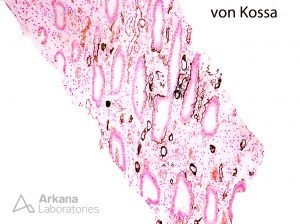Randall’s plaques are microscopic calcium phosphate deposits in the basement membranes of the thin loops of Henle. These plaques act as anchored nucleation sites for the formation of calcium oxalate crystals and are thought to play an important role in a subset of patients with calcium oxalate stones. They are rarely seen on medical kidney biopsies due to their location in an infrequently biopsied site. When present, basophilic crystalline deposits are present along tubular basement and nearby vascular bundles in the deep medulla as seen in these H&E-stained sections. These deposits highlight by von Kossa stain, a special stain which results in precipitation of silver ions within phosphate deposits.
Quick note: This post is to be used for informational purposes only and does not constitute medical or health advice. Each person should consult their own doctor with respect to matters referenced. Arkana Laboratories assumes no liability for actions taken in reliance upon the information contained herein.






